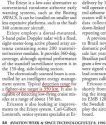In discussing radar detection range across different platforms, there are a few underlying factors that need to be understood in order to derive any meaningful understanding of the numbers.
Those factors include :
(1)The signal to noise (S/R) threshold that is used;
(2)The need to relate to comparative RCS;
(3)The radar mode used in establishing the number
(4)The probability of detection (P/D) that is adopted; and
(5)The difference between detection and tracking range.
(1) is never made available in the public domain and so the assumption is that they are similar across different platforms. This assumption is seriously flawed and consequently any comparison across platforms has this built-in underlying flaw.
(2)Any detection range quoted must relate to a RCS number. Without the RCS reference, the detection range is meaningless. Russian numbers tend to reference to fighter size target which can mean between 3 to 5 m2. US numbers tend to use 1 m2. Once the number and RCS is known, varying RCS can be determined using radar range equation. For example, a detection range of 100 kms against a 1 m2 target is equivalent to 150 kms against a 5 m2 target and 178 kms against a 10 m2 target.
(3)The search mode affects the detection range because of dwell time. The infamous 400 kms detection range claimed by the SU-35 IRBIS radar was based on a narrow search mode which effectively doubles the range.
(4)The PD % affects the detection range. The IRBIS radar claim to fame with its detection range was in using a 50 % PD. Western radars use 80 % PD.
(5)A firing solution is based on tracking range and not detection range. A rule of thumb conversion is to use 80 % of the detection range to get to tracking range. This only works for Western radar because as in (4) the PD adopted is 80 %. A valid track by definition requires a minimum three successive data points. The Russian in using 50 % PD will not get a reliable track from that range because 0.5X0.5X0.5 = 12.5 % PD As the saying goes, "you can cheat some of the people all of the time, all of the people some of the time but not all of the people all of the time". Cheaters do not win.
So in determining the JF-17 radar range, the question is more difficult to address because hardly any of the above is known and any number will be rather rubbery. In any case I have taken a stab. All ranges are expressed in kms.

.

